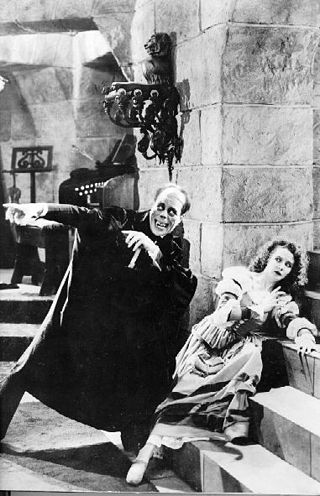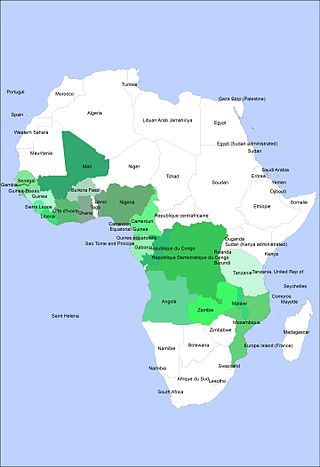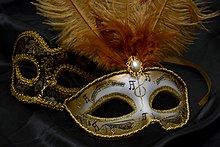
Carnival or Shrovetide is a festive season that occurs at the close of the Christian pre-Lenten period, consisting of Quinquagesima or Shrove Sunday, Shrove Monday, and Shrove Tuesday or Mardi Gras.

A masquerade ball is a special kind of formal ball which many participants attend in costume wearing masks. Less formal "costume parties" may be a descendant of this tradition. A masquerade ball usually encompasses music and dancing. These nighttime events are used for entertainment and celebrations.

A cloak is a type of loose garment worn over clothing, mostly but not always as outerwear for outdoor wear, serving the same purpose as an overcoat, protecting the wearer from the weather. It may form part of a uniform. People in many different societies may wear cloaks. Over time cloak designs have changed to match fashion and available textiles.

A mask is an object normally worn on the face, typically for protection, disguise, performance, or entertainment, and often employed for rituals and rites. Masks have been used since antiquity for both ceremonial and practical purposes, as well as in the performing arts and for entertainment. They are usually worn on the face, although they may also be positioned for effect elsewhere on the wearer's body.

The Mardi Gras Indians are African American carnival revelers in New Orleans, Louisiana, known for their elaborate suits and participation in Mardi Gras. The Mardi Gras Indians subculture emerged during the era of slavery from West African, Afro-Caribbean and Native American cultural practices. The Mardi Gras Indians' tradition is considered part of the African diasporan decorative aesthetic, and is an African-American art form.

The Trinidad and Tobago Carnival is an annual event held on the Monday and Tuesday before Ash Wednesday in Trinidad and Tobago. This event is well known for participants' colorful costumes and exuberant celebrations. There are numerous cultural events such as "band launch" fetes running in the lead up to the street parade on Carnival Monday and Tuesday. Traditionally, the festival is associated with calypso music, developed by enslaved West and Central Africans in 17th century Trinidad; however, Soca music has begun to replace calypso as the more popular musical genre for Carnival. Costume, stick-fighting, limbo, and steelpan competitions are important components of the festival.

A costume party or fancy dress party is a type of party, common in contemporary Western culture, in which many of the guests are dressed in costume, usually depicting a fictional or stock character, or historical figure. Such parties are popular in the United States, United Kingdom, Canada, Australia, Ireland and New Zealand, especially during Halloween.

The Carnival of Venice is an annual festival held in Venice, Italy, famous throughout the world for its elaborate costumes and masks. The Carnival ends on Shrove Tuesday, which is the day before the start of Lent on Ash Wednesday.

There have been many literary and dramatic works based on Gaston Leroux's 1910 novel The Phantom of the Opera, ranging from stage musicals to films to children's books. Some well known stage and screen adaptations of the novel are the 1925 film and the Andrew Lloyd Webber musical ; Susan Kay's 1990 Phantom is one of the best known novels and includes in-depth study of the title character's life and experiences.

Traditional African masks are worn in ceremonies and rituals across West, Central, and Southern Africa. They are used in events such as harvest celebrations, funerals, rites of passage, weddings, and coronations. Some societies also use masks to resolve disputes and conflicts.

Miss Masque is a fictional masked crime-fighter. She originally appeared in comic books published by Nedor Comics, and was later revived by AC Comics, America's Best Comics, and Dynamite Entertainment.

A masquerade ceremony is a cultural or religious event involving the wearing of masks. The practice has been seen throughout history from the prehistoric era to present day. They have a variety of themes. Their meanings can range from anything including life, death, and fertility. In the Dogon religion, the traditional beliefs of the Dogon people of Mali, there are several mask dances, including the Sigi festival. The Sigi entered the Guinness Book of Records as the "Longest religious ceremony".
Edgar Allan Poe's 1842 short story "The Masque of the Red Death" has been depicted and referenced numerous times in popular culture.

The Solo Batik Carnival or SBC is an annual carnival held in Solo City, Indonesia. The word "carnival" here is not related with the Christian pre-Lent celebration, but more of a festivities in general, with procession of dancers in extravagant costumes, with emphasis on the Indonesian motif of batik.

The Pink Dominos is a farce in three acts by James Albery based on the French farce Les Dominos roses by Alfred Hennequin and Alfred Delacour. It concerns a plan by two wives to test their husbands' fidelity at a masked ball and a mischievous maid who causes comic complications by wearing a gown similar to those worn by the wives. The "dominos" of the title are gowns with hoods and masks, worn at masquerades. The piece opened on March 31, 1877 and was exceptionally successful, running for a record-setting 555 performances. Charles Wyndham played one of the husbands and produced the piece at the Criterion Theatre. Augustus Harris played Henry and Fanny Josephs was one of the wives.

A cape is a clothing accessory or a sleeveless outer garment of any length that hangs loosely and connects either at the neck or shoulders. They usually cover the back, shoulders, and arms. They come in a variety of styles and have been used throughout history for many different reasons.

Carnival in French Guiana is a major event. Its style is described as Afro-Caribbean. A moveable holiday, it takes place between Epiphany and Ash Wednesday, ending on Mardi Gras. Known internationally for its Paré-masqué balls and its emblematic character, the Touloulou, it is considered the longest carnival in the world.
The Labyrinth of Jareth Masquerade Ball, shortened to LOJ or simply known as the Labyrinth Masquerade Ball, is an annual masquerade ball and cosplay event in Los Angeles, California. The ball was first held in 1997.

The Athelstan Club, formerly The Athelstan Masonic Temple, is a private gentlemen's club in Mobile, Alabama, US, founded in 1873, tracing its roots to a Masonic lodge established in 1870. By 1875 it had loosened membership to non-Masons and in 1876 formerly became The Athelstan Club. It admittedly admitted its first African American Member in 2011.




















